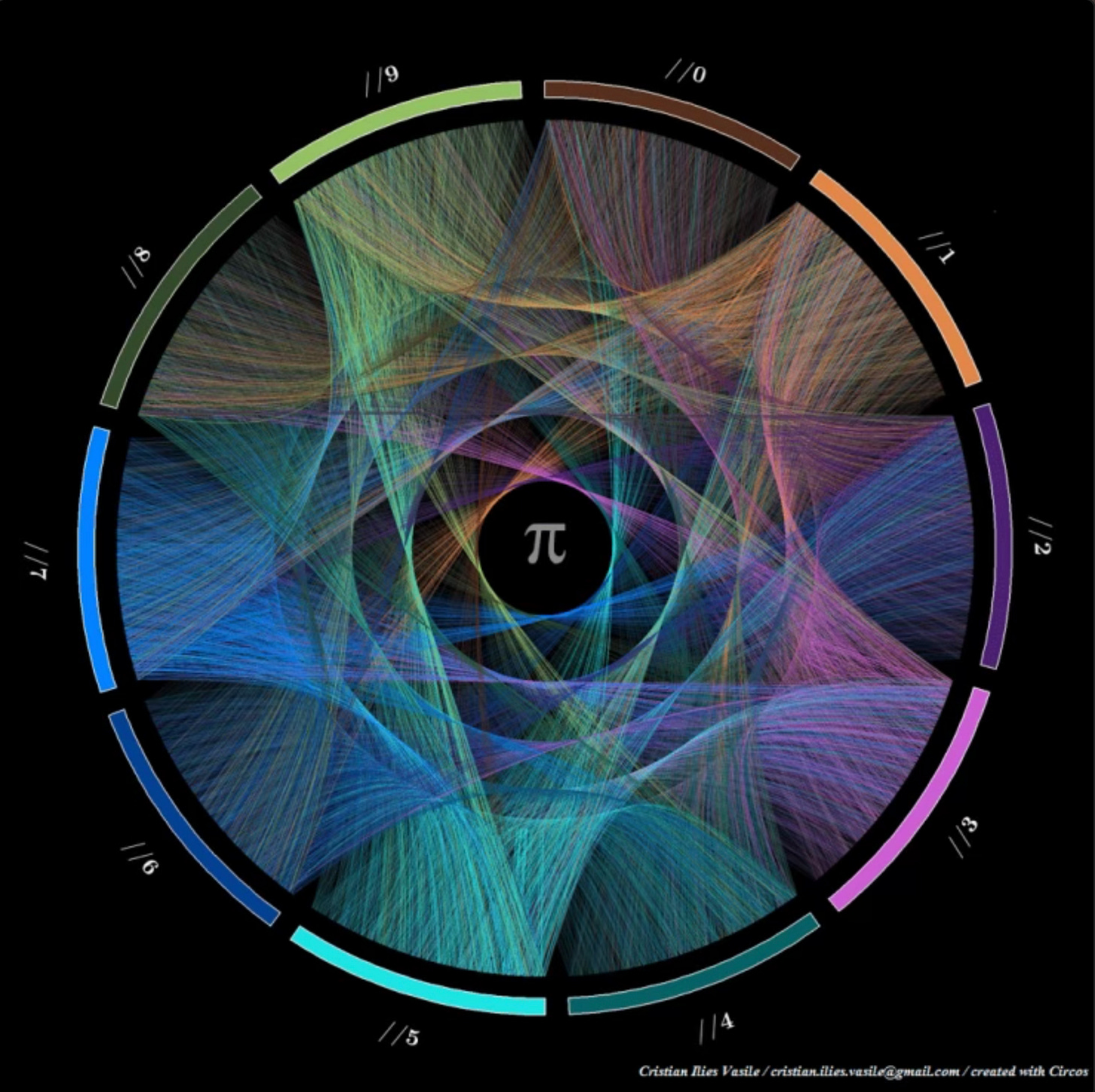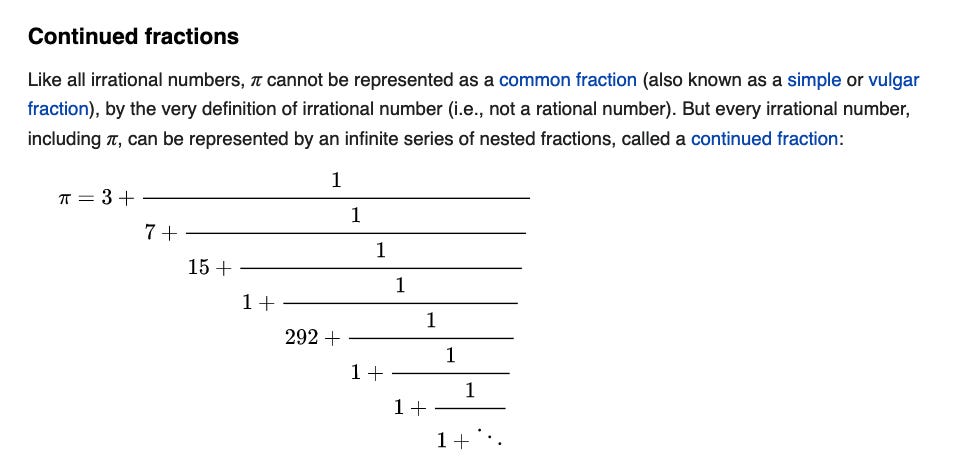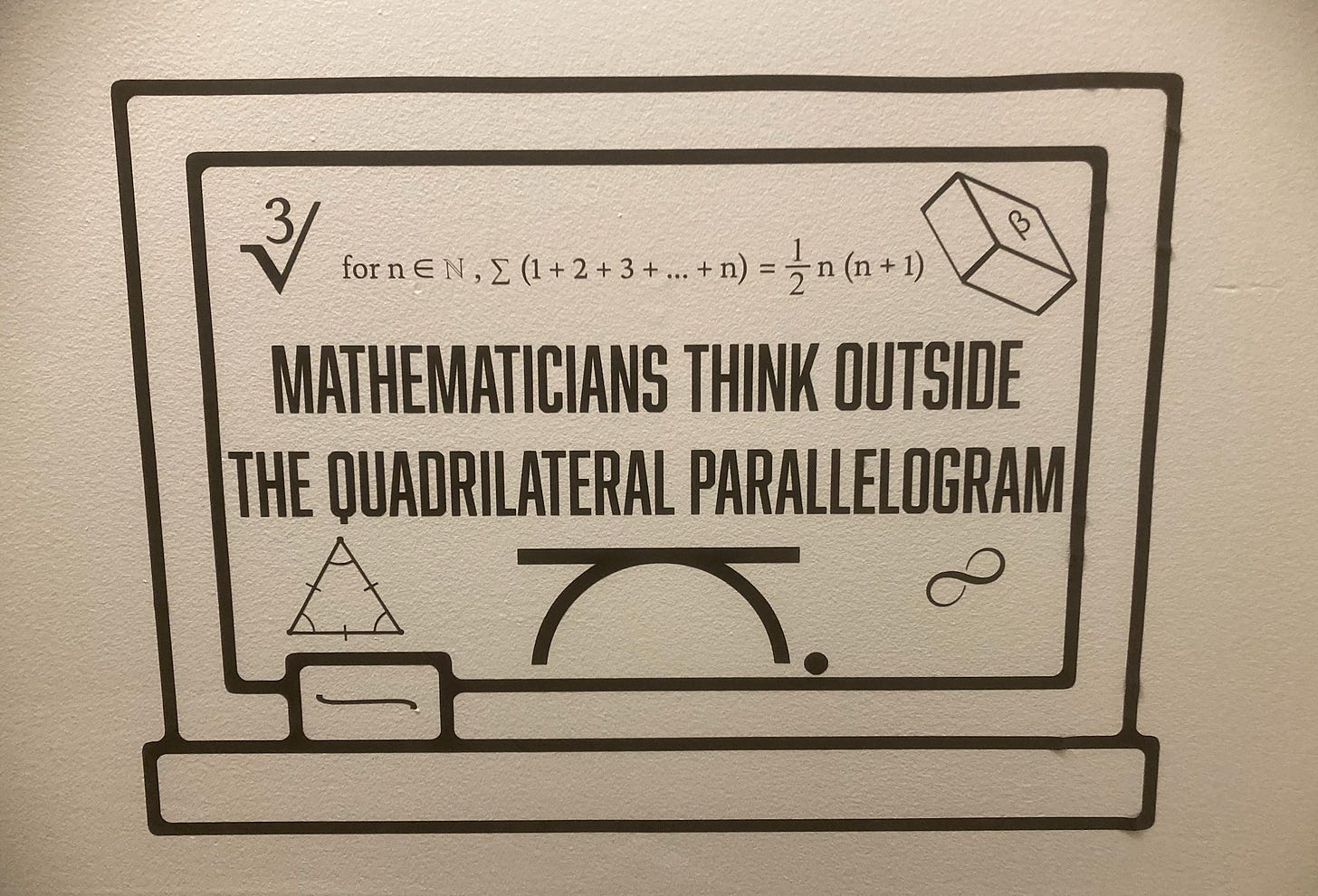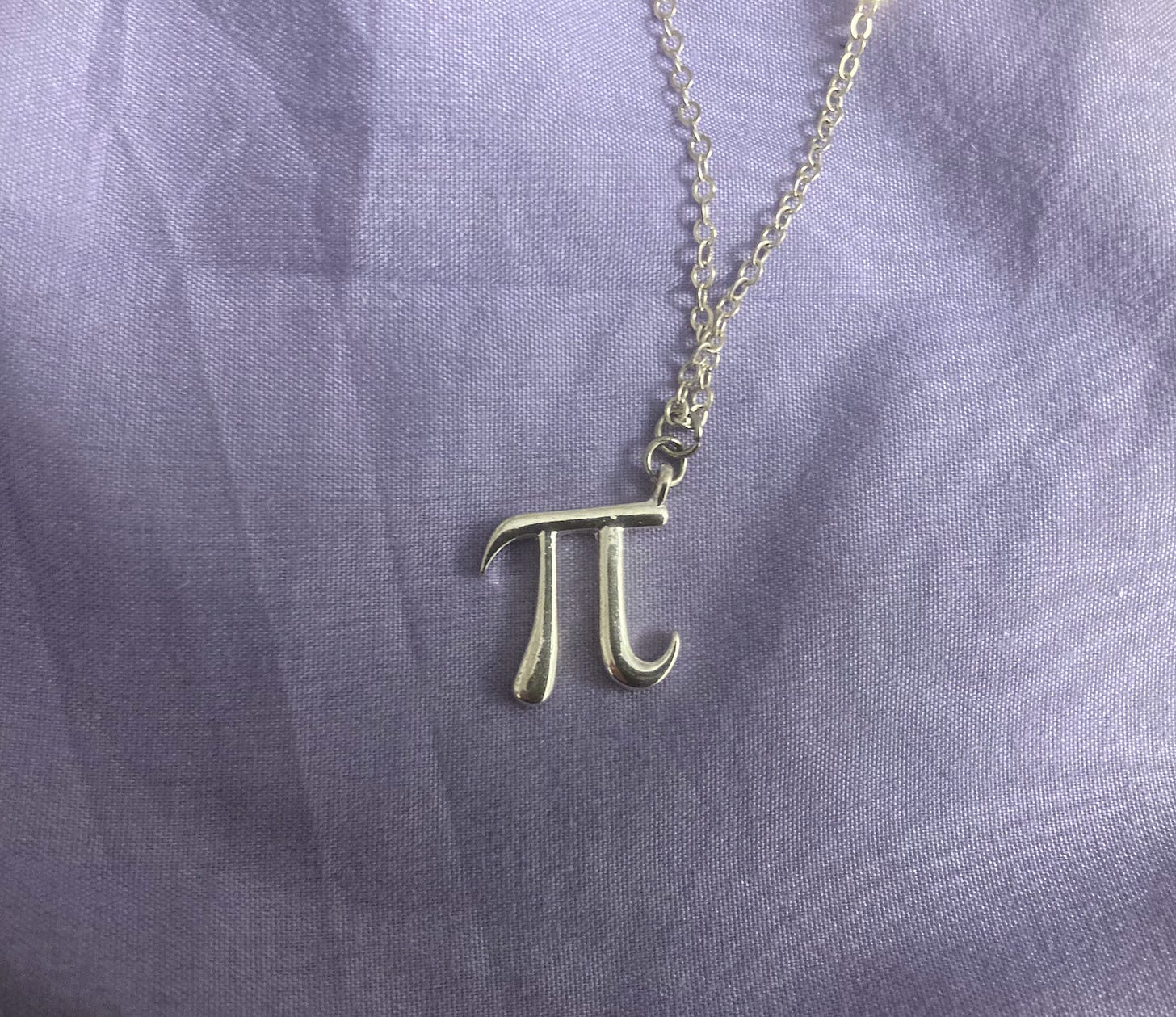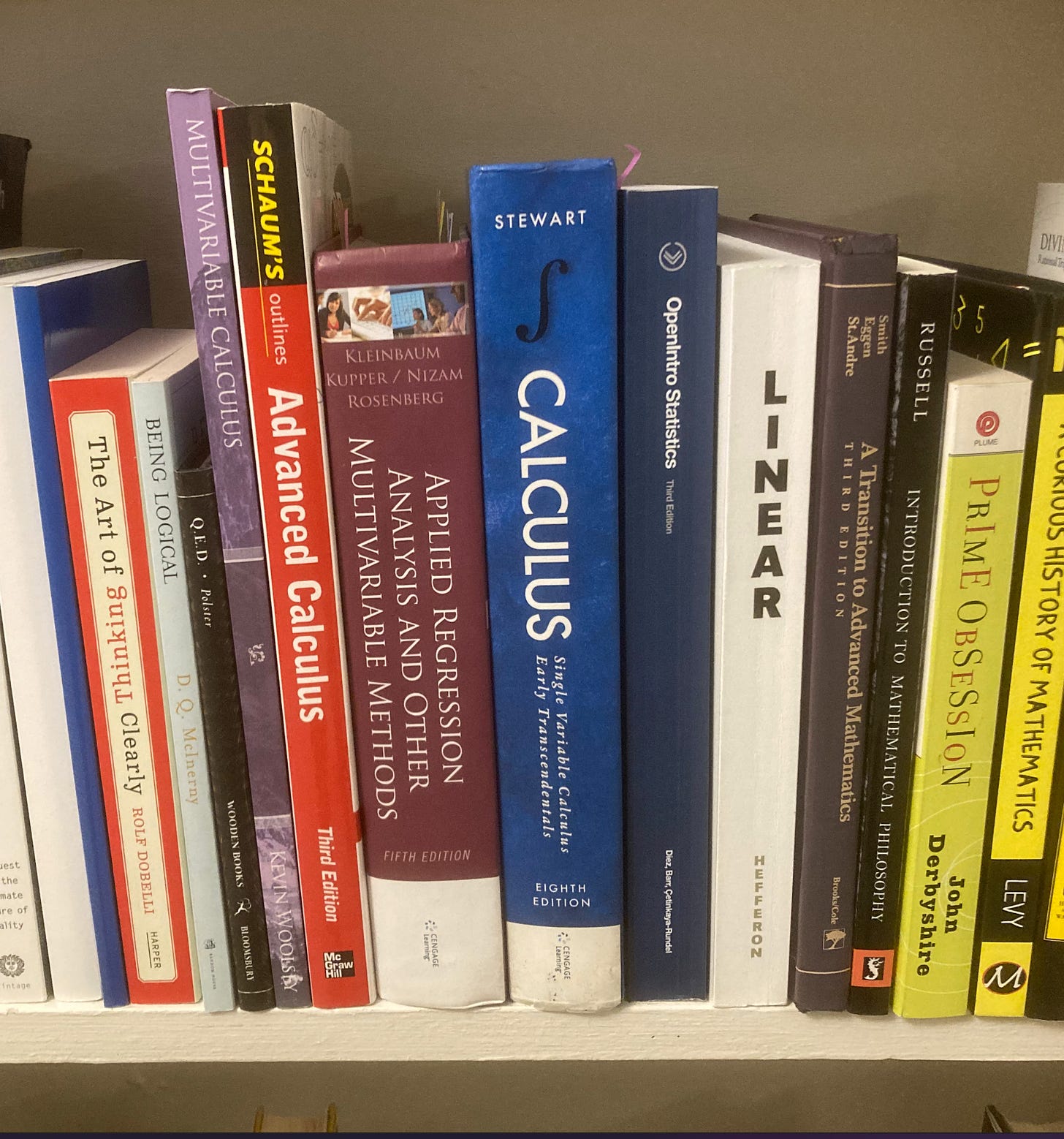Mathematics and Me
my unrequited love affair
If I ever write a memoir of my life’s mathematical trajectory, I will call it, simply, Counting.
As a little kid, I counted everything. Counting was one of the many obsessions of my childhood, and definitely the longest-lasting one. In my mind, my obsession with counting lasted my entire childhood—but that’s not actually true. There was a point when I wasn’t counting anymore; I was doing mathematics. Still, I think of it as counting, in part because the word and idea “counting” is a powerful part of my self-identity. Why? Largely because it was a long time before I thought of addition, subtraction, multiplication, and division as being things other than counting. I mentally conceived of these operations as simply moving things around and counting them again. (Which, if you think about it…kid-me wasn’t wrong.)
I loved counting for its own sake, for pure joy, but it was also a powerful tool to keep me sane. My childhood involved a lot of abuse, and counting was a big part of how I coped with it.
Numbers were solid and dependable, and always available to distract me.
I counted things that any little kid might count—toys and books and letters in words.
I counted the cans of soup in the pantry, and I was fascinated by the measuring spoons and their ratios.
I counted things few little kids were aware of, or could imagine—how many lashes it took a switch from this bush vs that one to wear out on my backside. Counting surely helped me endure, focusing on something besides the pain, but it also gave me real information to work with about one of the more unpleasant parts of my life. I knew when I was getting tougher, and that made me proud of myself.
Counting was also part of the best part of my childhood life—learning. The library had limits on a child’s card and I would count my books carefully, including how many books I had read in a day, week, month, or during the summer reading program. I counted the chapters, characters, and illustrations.
I loved Sesame Street (still do, really). Count von Count was my favorite character. Here’s a video I love, of the Count’s first day of school. (Warning: it’s so catchy that it will run through your mind continuously, maybe for days.)
I was amazed when my third grade teacher said we needed to memorize the multiplication tables. Understanding that multiplying was “fast adding”, it seemed weird to me that we wrote all these “fast adding” problems down, but I was game. Except for the 11’s, which gave me a little trouble (11x11 and 11x12) I had them all memorized in a day.
My pre-college education was in an unregulated church basement “school,” something that was really a homeschool co-op in all but name. Various church moms who didn’t work otherwise took turns “teaching” us. Thus, in high school I really didn’t have any math teachers. One of the moms tried very hard, seeing my interest, and found some videos about algebra at the library for me to watch. But I was mostly on my own to work through textbooks they provided. I didn’t get very far, but I worked hard at it and I enjoyed it.
The place where everything changed and mathematics changed from something I counted on into something I loved for its own sake is easy for me to spot: when I learned about pi.
What is pi?
Pi is a mathematical constant, the ratio of a circle’s circumference (the outside rim of it) to its diameter (the distance from one side to another; the straight line you would draw to cut it in half). The circumference is always slightly more than 3 times the diameter. Pi is irrational and infinite; it never ends. The usual approximation is 3.14, but it goes on without end. Computers have calculated over 62 trillion digits so far. This picture is my favorite representation of pi. Artists assigned each digit from 0 to 9 a color and then had a computer draw pi in those numbers. The harmony and beauty of it, combined with the lovely color choices, gives me great joy.
Pi can be expressed in many ways, befitting its role as something that turns up in every one of nature’s circles and in many other parts of nature, too.
Pi shows up in rivers. A river’s meandering is described by a property we call its sinuosity, the length along its winding path divided by the distance from source to ocean as the crow flies. The average river has a sinuosity of 3.14.
There are many lovely and beautiful ways to represent pi, like these (pics from Wikipedia).
Learning about pi sent me on a journey. Without real teachers, my ability to learn to solve problems was limited, but I read what I could and went over and over the problems in the books that had worked-out answers.
Unlike writing and drawing, at which I’ve had a fair amount of success developing skill on my own, mathematics has never come easily to me. I have needed teachers, tutors, a tremendous amount of work, and endless patience. And the greatest rewards have come from conquering the parts of it that are the hardest.
My favorite integration technique (integration is a calculus thing, for all you normies) is trigonometric substitution. Trig subs are tricky and difficult, with at least a dozen easy places to mess up. It took over 100 tries to get my first trig sub problem completely right, start to finish, and a full day to stop checking and re-checking and accept that I really had done it.
Now trig sub problems are my absolute most favorite thing to tutor, and I do them often for fun and relaxation. I can do them quickly, easily, and fluently. But make no mistake, I worked harder to earn that mastery than many people ever work to learn anything.
As Tom Hanks’s character says in A League of Their Own: “The hard is what makes it great.”
Majoring in Mathematics
As I have written about elsewhere, deciding to go to college was a major risk for me. In preparation for college, I spent a summer on Khan Academy working 10 to 12 hours a day on all of high school mathematics.
Because I had so much on the line, because the homework load was so massive, and because college was so stressful in other ways (like grinding poverty) it was hard to let myself enjoy it as much as I could have, but I still had moments of absolutely transcendent joy. My first proof writing class was like a series of intellectual orgasms—a simile I use carefully and with no intention of being vulgar. It took a lot of build-up to find the best possible technique for each argument, but the moment when I was done, when I knew I had a solid logical argument, something that was unequivocally and provably true—that moment was ecstasy.
Mathematics in My Present Life
I do a lot of tutoring, some for free. The school shut-downs of the last two years caused a lot of parents to have to face their own math phobia and try to make sense of Common Core (my take on which is here). This is the most fun part of my life right now, (though if vax mandates continue to drop that won’t be true for long, ha ha.) My favorite part is figuring out how to see through my student’s eyes and find a way to make them see what I see by introducing math to their model of the world. Very little makes me feel more satisfied.
In my job as a data scientist, I form hypotheses and then prove or disprove them using mathematics. This is usually, but not always, a result of statistics, a branch of mathematics I enjoy and specialized in during my undergraduate studies. (But calculus and trigonometry are still my great loves, and always will be—sssh! My statistics book can hear you. Keep it between us, ok?)
No Matter What Happens….
Mathematics is dependable. No matter how hard assholes on Twitter try to convince the world otherwise, 2 + 2 = 4 and not 5.
The branches on the tree of mathematics are the collections of rules that order the universe.
Learn to swing from them, and you can learn to cope with chaos.
In my view, selfless love, capacity for sacrifice, and the yearning to seek truth are what separates us from animals.
Mathematics is how and why we can know what is true. It is how we can see and understand the truth that we yearn to find.
Mathematics is a superpower, hidden in plain sight, and accessible to everyone willing and able to put in the effort.
I do not believe in any gods, but if I turn out to be wrong about that, one of the first things I will say to Him/Her/It will be:
Thank you for mathematics.
Pi Day (March 14) is coming up, so I will leave you with some photos of the mathematical decor I purchased for my apartment last year.



